人教版(2019)选择性必修 第二册 Unit 5 First Aid Using Language (2)课件(共35张PPT)
文档属性
| 名称 | 人教版(2019)选择性必修 第二册 Unit 5 First Aid Using Language (2)课件(共35张PPT) | 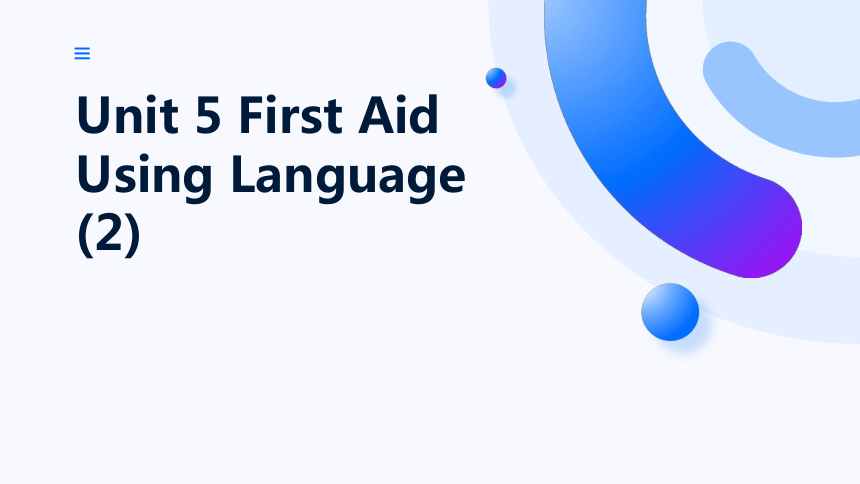 | |
| 格式 | pptx | ||
| 文件大小 | 1.2MB | ||
| 资源类型 | 教案 | ||
| 版本资源 | 人教版(2019) | ||
| 科目 | 英语 | ||
| 更新时间 | 2025-03-05 09:59:41 | ||
图片预览

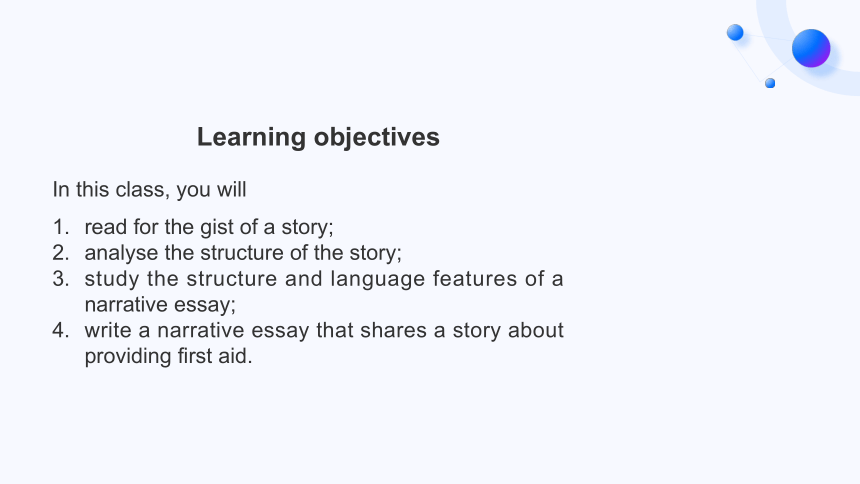
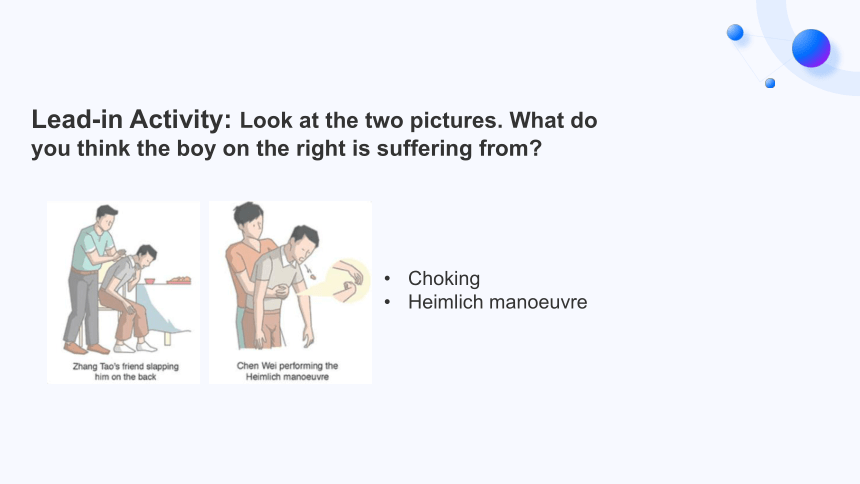

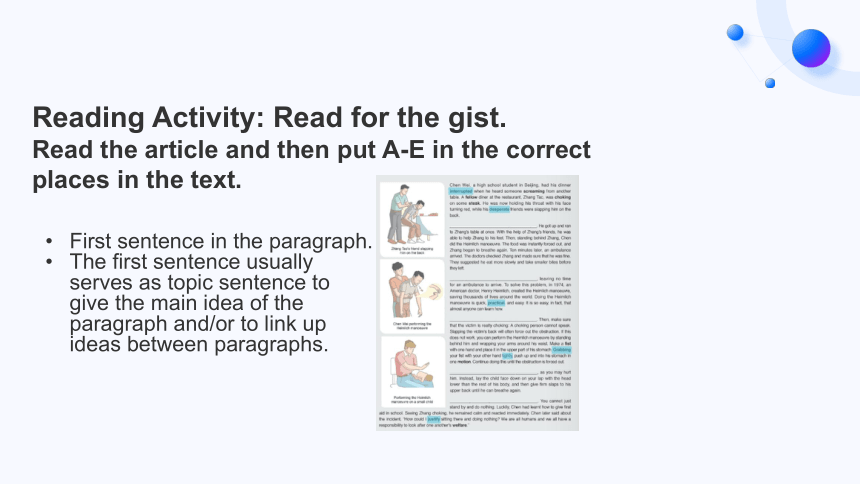

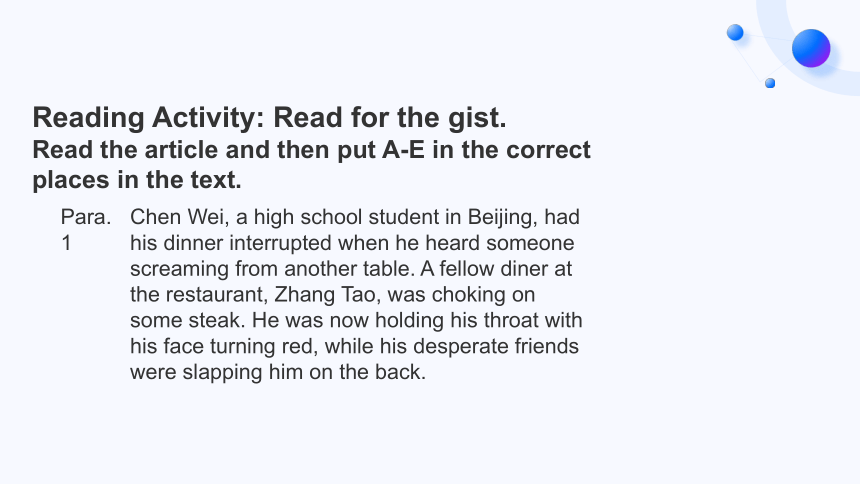

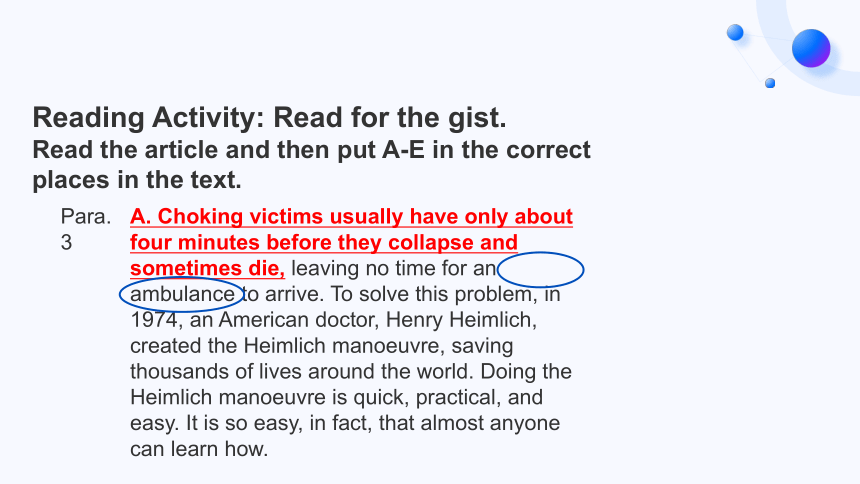
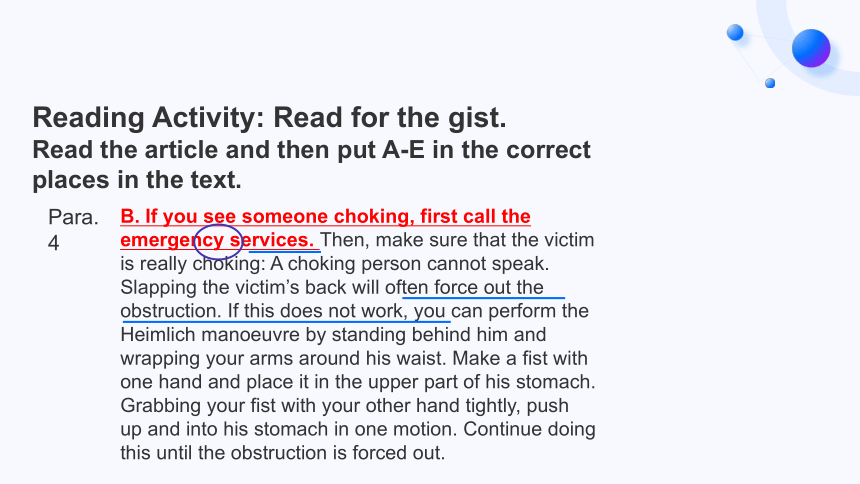
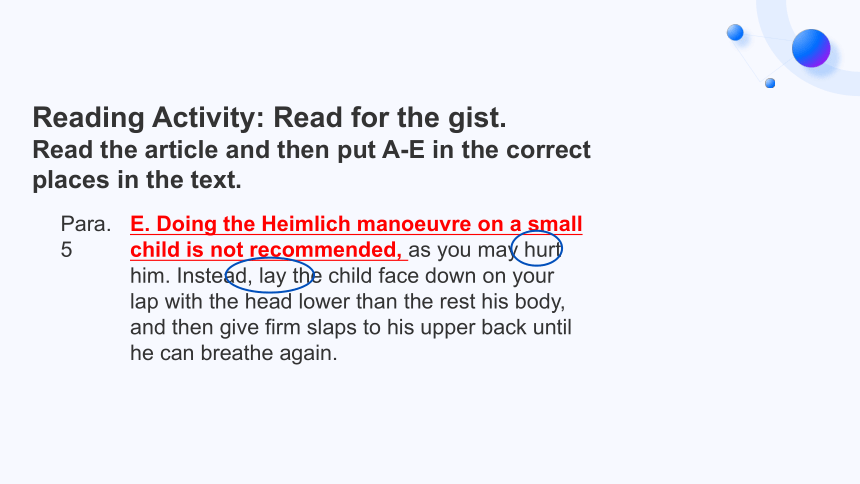
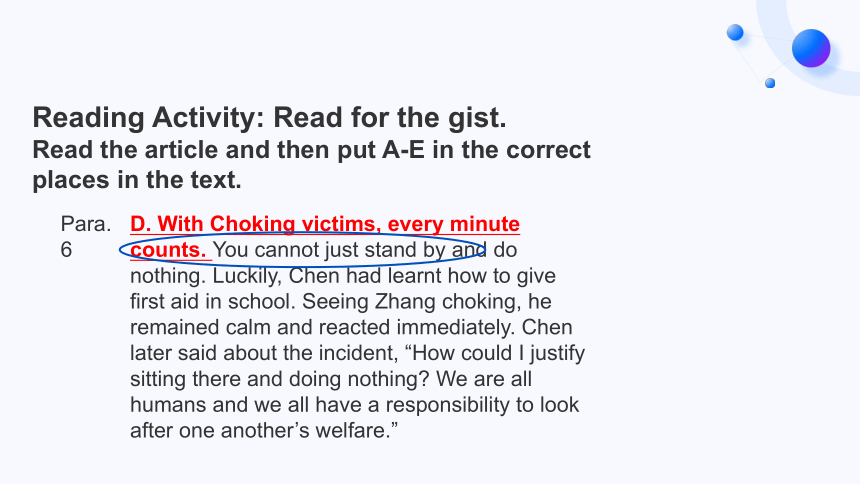
文档简介
(共35张PPT)
Unit 5 First Aid
Using Language (2)
Learning objectives
In this class, you will
read for the gist of a story;
analyse the structure of the story;
study the structure and language features of a narrative essay;
write a narrative essay that shares a story about providing first aid.
Choking
Heimlich manoeuvre
Lead-in Activity: Look at the two pictures. What do you think the boy on the right is suffering from
The reading article tells a story of a high school student named Chen Wei who used the Heimlich maneuver to save a person’s life.
The article not only describes the process of his rescue of a choking victim, but also introduces the history and operation of Heimlich first aid.
Reading Activity: Read for the gist.
Read the article and then summarize the main idea.
First sentence in the paragraph.
The first sentence usually serves as topic sentence to give the main idea of the paragraph and/or to link up ideas between paragraphs.
Reading Activity: Read for the gist.
Read the article and then put A-E in the correct places in the text.
A Choking victims usually have only about four minutes before they collapse and sometimes die
B If you see someone choking, first call the emergency services
C Chen wasted no time
D With choking victims, every minute counts
E Doing the Heimlich manoeuvre on a small child is not recommended
Reading Activity: Read for the gist.
Read the article and then put A-E in the correct places in the text.
Para.1 Chen Wei, a high school student in Beijing, had his dinner interrupted when he heard someone screaming from another table. A fellow diner at the restaurant, Zhang Tao, was choking on some steak. He was now holding his throat with his face turning red, while his desperate friends were slapping him on the back.
Reading Activity: Read for the gist.
Read the article and then put A-E in the correct places in the text.
Para.2 C. Chen wasted no time. He got up and ran to Zhang’s table at once. With the help of Zhang’s friends, he was able to help Zhang to his feet. Then, standing behind Zhang, Chen did the Heimlich manoeuvre. The food was instantly forced out, and Zhang began to breathe again. Ten minutes later, an ambulance arrived. The doctors checked Zhang and made sure that he was fine. They suggested he eat more slowly and take smaller bites before they left.
Reading Activity: Read for the gist.
Read the article and then put A-E in the correct places in the text.
Para.3 A. Choking victims usually have only about four minutes before they collapse and sometimes die, leaving no time for an ambulance to arrive. To solve this problem, in 1974, an American doctor, Henry Heimlich, created the Heimlich manoeuvre, saving thousands of lives around the world. Doing the Heimlich manoeuvre is quick, practical, and easy. It is so easy, in fact, that almost anyone can learn how.
Reading Activity: Read for the gist.
Read the article and then put A-E in the correct places in the text.
Para.4 B. If you see someone choking, first call the emergency services. Then, make sure that the victim is really choking: A choking person cannot speak. Slapping the victim’s back will often force out the obstruction. If this does not work, you can perform the Heimlich manoeuvre by standing behind him and wrapping your arms around his waist. Make a fist with one hand and place it in the upper part of his stomach. Grabbing your fist with your other hand tightly, push up and into his stomach in one motion. Continue doing this until the obstruction is forced out.
Reading Activity: Read for the gist.
Read the article and then put A-E in the correct places in the text.
Para.5 E. Doing the Heimlich manoeuvre on a small child is not recommended, as you may hurt him. Instead, lay the child face down on your lap with the head lower than the rest his body, and then give firm slaps to his upper back until he can breathe again.
Reading Activity: Read for the gist.
Read the article and then put A-E in the correct places in the text.
Para.6 D. With Choking victims, every minute counts. You cannot just stand by and do nothing. Luckily, Chen had learnt how to give first aid in school. Seeing Zhang choking, he remained calm and reacted immediately. Chen later said about the incident, “How could I justify sitting there and doing nothing We are all humans and we all have a responsibility to look after one another’s welfare.”
Reading Activity: Read for the gist.
Read the article and then put A-E in the correct places in the text.
Reading Activity: Read for the details.
Read the article again and choose the correct words to complete the sentences.
Chen Wei was a friend/complete stranger to Zhang Tao.
When Chen Wei reached Zhang Tao, Zhang Tao was sitting on the chair/standing.
The Heimlich manoeuvre is quite easy/difficult to do.
You will know that the victim is choking if he cannot speak/stops breathing.
To help a small child who is choking, you need to lay the child face up/down on your lap and slap his upper back.
Chen Wei was able to save Zhang Tao because he learnt the Heimlich manoeuvre at school/from a first-aid manual.
Reading Activity: Read for the details.
Read the article again and choose the correct words to complete the sentences.
Chen Wei was a friend/complete stranger to Zhang Tao.
When Chen Wei reached Zhang Tao, Zhang Tao was sitting on the chair/standing.
The Heimlich manoeuvre is quite easy/difficult to do.
You will know that the victim is choking if he cannot speak/stops breathing.
To help a small child who is choking, you need to lay the child face up/down on your lap and slap his upper back.
Chen Wei was able to save Zhang Tao because he learnt the Heimlich manoeuvre at school/from a first-aid manual.
Reading Activity: Read for the details
Read the article again and choose the correct words to complete the sentences.
Reading Activity: Read for the structure of a narrative essay.
the set-up
who
what
where
the conflict
a challenge or difficulty
the conclusion
the end of the story
Part 1:
Who were the people involved
What happened
Where did it happen
Part 2: What did Chen Wei do
Part 3: How does the story end
Reading Activity: Read for the structure of a narrative essay.
Reread the article, and then answer the questions below.
Part 1:
Who were the people involved
What happened
Where did it happen
Chen Wei, a high school student in Beijing, and Zhang Tao, a fellow diner at a restaurant.
Zhang Tao was choking on some steak while eating.
At a restaurant.
Reading Activity: Read for the structure of a narrative essay.
Reread the article, and then answer the questions below.
Part 2: What did Chen Wei do
Part 3: How does the story end
Chen Wei performed the Heimlich manoeuvre on Zhang Tao.
Chen Wei saved Zhang Tao, then the ambulance came and doctors checked Zhang Tao and said that he was fine.
Reading Activity: Read for the structure of a narrative essay.
Reread the article, and then answer the questions below.
What purpose does the quote at the end of the essay serve
… Chen later said about the incident, “How could I justify sitting there and doing nothing We are all humans and we all have a responsibility to look after one another’s welfare.”
Reading Activity: Read for the structure of a narrative essay.
Reread the article, and then answer the questions below.
What purpose does the quote at the end of the essay serve
Reading Activity: Read for the structure of a narrative essay.
Reread the article, and then answer the questions below.
It provides a good way to wrap up the essay. It also tells the reader about Chen Wei’s emotions and opinions, and gives unique insight into his character.
Reading Activity: Read for the structure of a narrative essay.
Organize the structure of the article.
Part 1 (Para. 1-2): the story of a choking incident
Part 2 (Para. 3-5): the introduction of the Heimlich manoeuvre
Part 3 (Para. 6): comments on the choking incident
Reading Activity: Read for the language.
Read again and underline the language for describing actions.
to introduce the emergency
to perform Heimlich manoeuvre
to perform first aid on children
Reading Activity: Read for the language.
Read again and underline the language for describing actions.
to introduce the emergency
choke on some steak;
hold his throat with his face turning red;
help his desperate friend to his feet.
Reading Activity: Read for the language.
Read again and underline the language for describing actions.
to perform Heimlich manoeuvre
make sure that the victim is really choking
stand behind him; wrap your arms around his waist;
make a fist; place it in the upper part of his stomach;
Reading Activity: Read for the language.
Read again and underline the language for describing actions.
to perform Heimlich manoeuvre
grab your fist with your other hand tightly;
push up and into his stomach in one motion;
continue doing this until the obstruction is forced out.
Reading Activity: Read for the language.
Read again and underline the language for describing actions.
to perform first aid on children
lay the child face down on your lap with the head lower than the rest of his body;
give firm slaps to his upper back until he can breathe again.
Reading Activity: Summarize.
The structure of narrative essays:
the set-up: who, what, and where.
the conflict: a challenge or difficulty.
the conclusion: the end of the story.
Language features of narrative essays:
clear and concise;
written in the first person or third person;
written in active voice;
informal words and phrases.
Recall your experiences of giving first aid in an emergency. If you have never had any experiences, share stories you have read or heard about, or think up a situation.
Write an outline of the three parts in your story. Then think of a good quote to sum things up.
Write your narrative essay.
Writing Activity:
Use what you have learnt to write a narrative essay that shares a story about providing first aid.
Questions Key words
Part 1 Who What Where
Part 2 The process
Part 3 The end?
Part 4 Any comments
Pre-writing Activity: Brainstorm and decide the content.
Post-writing Activity: Use this checklist to revise your draft.
Is the narrative essay clear
Does it have three parts
Does the first part tell you about who, what, and where
Does the second part show a conflict
Does the third part give the conclusion
Is there a good quote to sum things up
Are the details of the story easy to understand
Sample essay:
One morning, David was working at his home office while watching his infant daughter Jane who was crawling on the floor. Suddenly, he noticed that she had picked something up and put it in her mouth. Then she began to move like she was struggling. He quickly jumped from his chair and ran over and picked her up. Going back to his chair, he held her in his lap and saw that she was still struggling with a frightened look on her face. However, she was not crying or making a sound.
He carefully opened her mouth to see if there was obstruction. Not finding anything, he then gave her a few hard slaps on her back.
It worked! Within seconds a small button fell from her mouth onto the floor, and she was breathing once again. Thanks to David’s quick thinking, Jane was saved.
Sample essay:
金山办公软件有限公司
汇报人:WPS
Sample essay:
David now teaches life-saving techniques at the local college, and he uses this story to impress upon students the need for quick action. “When seconds count,” he said, “an ambulance is often minutes away.”
Homework
Finish and revise your draft.
Unit 5 First Aid
Using Language (2)
Learning objectives
In this class, you will
read for the gist of a story;
analyse the structure of the story;
study the structure and language features of a narrative essay;
write a narrative essay that shares a story about providing first aid.
Choking
Heimlich manoeuvre
Lead-in Activity: Look at the two pictures. What do you think the boy on the right is suffering from
The reading article tells a story of a high school student named Chen Wei who used the Heimlich maneuver to save a person’s life.
The article not only describes the process of his rescue of a choking victim, but also introduces the history and operation of Heimlich first aid.
Reading Activity: Read for the gist.
Read the article and then summarize the main idea.
First sentence in the paragraph.
The first sentence usually serves as topic sentence to give the main idea of the paragraph and/or to link up ideas between paragraphs.
Reading Activity: Read for the gist.
Read the article and then put A-E in the correct places in the text.
A Choking victims usually have only about four minutes before they collapse and sometimes die
B If you see someone choking, first call the emergency services
C Chen wasted no time
D With choking victims, every minute counts
E Doing the Heimlich manoeuvre on a small child is not recommended
Reading Activity: Read for the gist.
Read the article and then put A-E in the correct places in the text.
Para.1 Chen Wei, a high school student in Beijing, had his dinner interrupted when he heard someone screaming from another table. A fellow diner at the restaurant, Zhang Tao, was choking on some steak. He was now holding his throat with his face turning red, while his desperate friends were slapping him on the back.
Reading Activity: Read for the gist.
Read the article and then put A-E in the correct places in the text.
Para.2 C. Chen wasted no time. He got up and ran to Zhang’s table at once. With the help of Zhang’s friends, he was able to help Zhang to his feet. Then, standing behind Zhang, Chen did the Heimlich manoeuvre. The food was instantly forced out, and Zhang began to breathe again. Ten minutes later, an ambulance arrived. The doctors checked Zhang and made sure that he was fine. They suggested he eat more slowly and take smaller bites before they left.
Reading Activity: Read for the gist.
Read the article and then put A-E in the correct places in the text.
Para.3 A. Choking victims usually have only about four minutes before they collapse and sometimes die, leaving no time for an ambulance to arrive. To solve this problem, in 1974, an American doctor, Henry Heimlich, created the Heimlich manoeuvre, saving thousands of lives around the world. Doing the Heimlich manoeuvre is quick, practical, and easy. It is so easy, in fact, that almost anyone can learn how.
Reading Activity: Read for the gist.
Read the article and then put A-E in the correct places in the text.
Para.4 B. If you see someone choking, first call the emergency services. Then, make sure that the victim is really choking: A choking person cannot speak. Slapping the victim’s back will often force out the obstruction. If this does not work, you can perform the Heimlich manoeuvre by standing behind him and wrapping your arms around his waist. Make a fist with one hand and place it in the upper part of his stomach. Grabbing your fist with your other hand tightly, push up and into his stomach in one motion. Continue doing this until the obstruction is forced out.
Reading Activity: Read for the gist.
Read the article and then put A-E in the correct places in the text.
Para.5 E. Doing the Heimlich manoeuvre on a small child is not recommended, as you may hurt him. Instead, lay the child face down on your lap with the head lower than the rest his body, and then give firm slaps to his upper back until he can breathe again.
Reading Activity: Read for the gist.
Read the article and then put A-E in the correct places in the text.
Para.6 D. With Choking victims, every minute counts. You cannot just stand by and do nothing. Luckily, Chen had learnt how to give first aid in school. Seeing Zhang choking, he remained calm and reacted immediately. Chen later said about the incident, “How could I justify sitting there and doing nothing We are all humans and we all have a responsibility to look after one another’s welfare.”
Reading Activity: Read for the gist.
Read the article and then put A-E in the correct places in the text.
Reading Activity: Read for the details.
Read the article again and choose the correct words to complete the sentences.
Chen Wei was a friend/complete stranger to Zhang Tao.
When Chen Wei reached Zhang Tao, Zhang Tao was sitting on the chair/standing.
The Heimlich manoeuvre is quite easy/difficult to do.
You will know that the victim is choking if he cannot speak/stops breathing.
To help a small child who is choking, you need to lay the child face up/down on your lap and slap his upper back.
Chen Wei was able to save Zhang Tao because he learnt the Heimlich manoeuvre at school/from a first-aid manual.
Reading Activity: Read for the details.
Read the article again and choose the correct words to complete the sentences.
Chen Wei was a friend/complete stranger to Zhang Tao.
When Chen Wei reached Zhang Tao, Zhang Tao was sitting on the chair/standing.
The Heimlich manoeuvre is quite easy/difficult to do.
You will know that the victim is choking if he cannot speak/stops breathing.
To help a small child who is choking, you need to lay the child face up/down on your lap and slap his upper back.
Chen Wei was able to save Zhang Tao because he learnt the Heimlich manoeuvre at school/from a first-aid manual.
Reading Activity: Read for the details
Read the article again and choose the correct words to complete the sentences.
Reading Activity: Read for the structure of a narrative essay.
the set-up
who
what
where
the conflict
a challenge or difficulty
the conclusion
the end of the story
Part 1:
Who were the people involved
What happened
Where did it happen
Part 2: What did Chen Wei do
Part 3: How does the story end
Reading Activity: Read for the structure of a narrative essay.
Reread the article, and then answer the questions below.
Part 1:
Who were the people involved
What happened
Where did it happen
Chen Wei, a high school student in Beijing, and Zhang Tao, a fellow diner at a restaurant.
Zhang Tao was choking on some steak while eating.
At a restaurant.
Reading Activity: Read for the structure of a narrative essay.
Reread the article, and then answer the questions below.
Part 2: What did Chen Wei do
Part 3: How does the story end
Chen Wei performed the Heimlich manoeuvre on Zhang Tao.
Chen Wei saved Zhang Tao, then the ambulance came and doctors checked Zhang Tao and said that he was fine.
Reading Activity: Read for the structure of a narrative essay.
Reread the article, and then answer the questions below.
What purpose does the quote at the end of the essay serve
… Chen later said about the incident, “How could I justify sitting there and doing nothing We are all humans and we all have a responsibility to look after one another’s welfare.”
Reading Activity: Read for the structure of a narrative essay.
Reread the article, and then answer the questions below.
What purpose does the quote at the end of the essay serve
Reading Activity: Read for the structure of a narrative essay.
Reread the article, and then answer the questions below.
It provides a good way to wrap up the essay. It also tells the reader about Chen Wei’s emotions and opinions, and gives unique insight into his character.
Reading Activity: Read for the structure of a narrative essay.
Organize the structure of the article.
Part 1 (Para. 1-2): the story of a choking incident
Part 2 (Para. 3-5): the introduction of the Heimlich manoeuvre
Part 3 (Para. 6): comments on the choking incident
Reading Activity: Read for the language.
Read again and underline the language for describing actions.
to introduce the emergency
to perform Heimlich manoeuvre
to perform first aid on children
Reading Activity: Read for the language.
Read again and underline the language for describing actions.
to introduce the emergency
choke on some steak;
hold his throat with his face turning red;
help his desperate friend to his feet.
Reading Activity: Read for the language.
Read again and underline the language for describing actions.
to perform Heimlich manoeuvre
make sure that the victim is really choking
stand behind him; wrap your arms around his waist;
make a fist; place it in the upper part of his stomach;
Reading Activity: Read for the language.
Read again and underline the language for describing actions.
to perform Heimlich manoeuvre
grab your fist with your other hand tightly;
push up and into his stomach in one motion;
continue doing this until the obstruction is forced out.
Reading Activity: Read for the language.
Read again and underline the language for describing actions.
to perform first aid on children
lay the child face down on your lap with the head lower than the rest of his body;
give firm slaps to his upper back until he can breathe again.
Reading Activity: Summarize.
The structure of narrative essays:
the set-up: who, what, and where.
the conflict: a challenge or difficulty.
the conclusion: the end of the story.
Language features of narrative essays:
clear and concise;
written in the first person or third person;
written in active voice;
informal words and phrases.
Recall your experiences of giving first aid in an emergency. If you have never had any experiences, share stories you have read or heard about, or think up a situation.
Write an outline of the three parts in your story. Then think of a good quote to sum things up.
Write your narrative essay.
Writing Activity:
Use what you have learnt to write a narrative essay that shares a story about providing first aid.
Questions Key words
Part 1 Who What Where
Part 2 The process
Part 3 The end?
Part 4 Any comments
Pre-writing Activity: Brainstorm and decide the content.
Post-writing Activity: Use this checklist to revise your draft.
Is the narrative essay clear
Does it have three parts
Does the first part tell you about who, what, and where
Does the second part show a conflict
Does the third part give the conclusion
Is there a good quote to sum things up
Are the details of the story easy to understand
Sample essay:
One morning, David was working at his home office while watching his infant daughter Jane who was crawling on the floor. Suddenly, he noticed that she had picked something up and put it in her mouth. Then she began to move like she was struggling. He quickly jumped from his chair and ran over and picked her up. Going back to his chair, he held her in his lap and saw that she was still struggling with a frightened look on her face. However, she was not crying or making a sound.
He carefully opened her mouth to see if there was obstruction. Not finding anything, he then gave her a few hard slaps on her back.
It worked! Within seconds a small button fell from her mouth onto the floor, and she was breathing once again. Thanks to David’s quick thinking, Jane was saved.
Sample essay:
金山办公软件有限公司
汇报人:WPS
Sample essay:
David now teaches life-saving techniques at the local college, and he uses this story to impress upon students the need for quick action. “When seconds count,” he said, “an ambulance is often minutes away.”
Homework
Finish and revise your draft.
